Well, because I actually liked both composing and the finished product of this piece, I’m going to talk about it.
First and foremost is probably the structure of the piece. There are a few unusual aspects of this piece, particularly when compared to sonati of the Common Practice Period™. The most obvious one is probably the overall movement count. There is a grand total of one movement in this sonata. Originally, it had two other movements, but I ultimately decided that they weren’t in the interest of the feel of the sonata as a whole. Both of them combined both minimalism and impressionism together, and the second movement in particular didn’t really feel like it was a part of the same work in any capacity. The third movement had the right feeling, but I didn’t feel that it was the right ending material. So I cut both of them to possibly use in something else down the line.
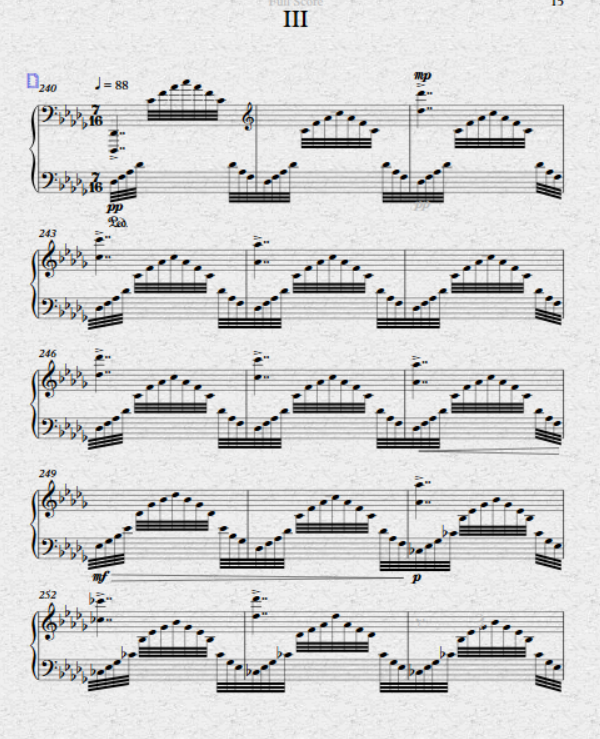
The second unusual part of the sonata is the actual form of the one movement; instead of using the conventional sonata-allegro form, conforming to the conventions of the Common Practice Period™, I opted to instead experiment with it a bit more. The only way I can really describe it would be a hybrid of sonata-allegro and rounded binary. The conclusion is ultimately this: while the movement has a two distinct sections, the B section is actually developed material from the exposition. Combining this with the lack of the second half of the recapitulation at the end, I have essentially written a hybrid form that I will call sonata-rounded binary. Where the recapitulation should finish is with the closing material after the second theme, but I opted to instead end the work on a cadential extension of what is essentially the transitional material in the exposition into an ambiguous ending that I will elaborate on later.
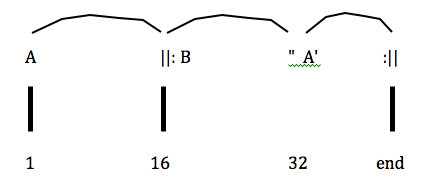

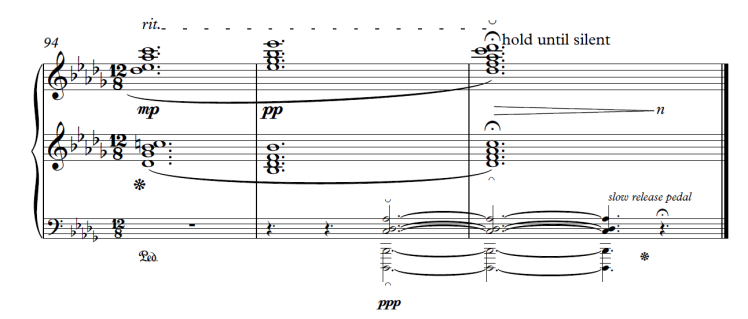
The story of this piece comes in a few segments. The first theme of the piece was an idea I had after a lecture I had attended on the stylistic conventions of the music of Claude Debussy in a Music History course in my sophomore year of my undergrad degree. My professor for the course used the word “dream-like” to describe Debussy’s music, which hadn’t really occurred to me at the time. After the lecture, I went to a practice room like a good composition major and I stared at the keyboard for a bit before I started messing with the first theme. Now, the rhythm wasn’t set in stone until quite a bit later. But I did find that I wanted to experiment with a new texture, also discussed in that lecture. That texture was parallelism.
This work is also a dedication and farewell to two important people in my life who had passed away quite recently; the first was my mother’s father, George Heman, my grandfather, who passed away shortly before I left for my second year of college. Due to the high cost of last minute, cross-country plane travel, I was unable to attend his funeral and attend college on the same budget. I opted to attend college instead, as would be his last wish. The other person who this work is dedicated to was one of my bowling coaches and the grandfather of our team in the junior league, Paul Pullman, who had passed away over Winter Break that year. Fortunately, I was able to attend the funeral service and meet back up with my team.
This work is based on my own philosophy behind what saying goodbye should actually mean in this case. It’s sad that you have to say goodbye to somebody, which is where I draw the solemnness of the work from, but I also think that it’s important to realize that their being is free from the pain of the mortal world. They aren’t in pain anymore, and for that reason, we should rejoice in their memory and their life they had, instead of focus on the pain of their loss. This is the other side of the duality of the work; it represents both dreams and the afterlife, life and death, and the interconnected nature of both of them. The climax is the point of ascension, into what people would call heaven, and everything after that is the sudden loss that you aren’t returning back to the world you left behind.
What I wanted to create was a sense of enigma and introspectiveness throughout the work, using the climax as a point of awakening, if you will. To do this, I deliberately muddy the lines between harmony and melody, as they often function as the same entity in this work, as well as a constant, almost random shift in the pulse. At the same time, I wanted to convey that the enigma confronting the listener is not a malicious one, but more of a self-reflective one. It’s the haze that surrounds dreams, that muddies them, and that alters them, pushing them just beyond the limits of perception, with the occasional fantastical, vivid scene that sticks with you for a while.
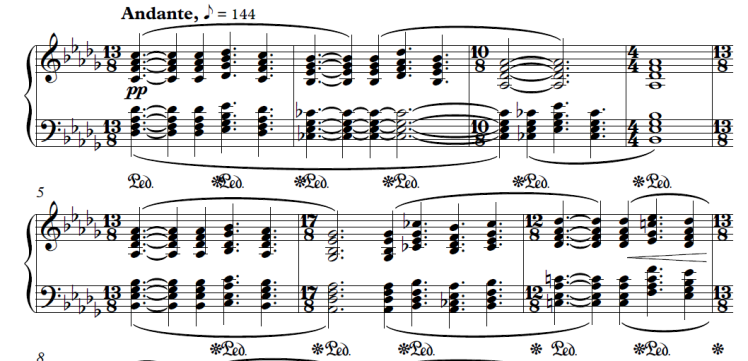
The first thing you will probably notice, aside from the lowest tier of the “Flats from Hell” keys, is the time signatures. As in, it changes nearly every measure. And this is something that continues through the entire sonata, in varying degrees of extremity. Because I was aiming to write in more of an Impressionistic style, I wanted to have a fairly obscure, but exacting pulse throughout the work, with little room for rubato through the opening phrases. This part contrasts Impressionism in general, though I feel the shifting dotted quarters and undotted quarters helps obscure the eighth note pulse rather nicely, while still retaining enough of a regular harmonic rhythm to be recognizable.
The second theme of the movement is similar in style and texture, though thinner and is bit more blurred between major and mixolydian, though the second phrase of the theme is also blurs into lydian as well, further pushing the foreshadowing of the climax. The second repetition of the second theme changes the rhythm and meter up a bit and pushes into more rhythmic complexity between both hands. The closing of the theme has one of the only Common Practice Period™ cadences in the work, though it is highly obscured with a pair of pedal points surrounding a Vd-omit5, closing the “Exposition,” and setting the stage for the Development.
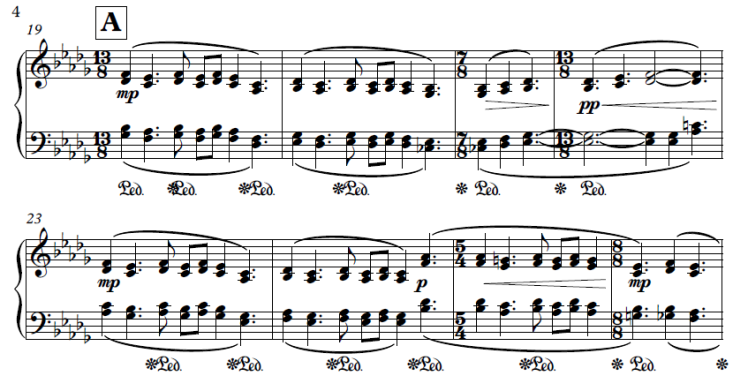
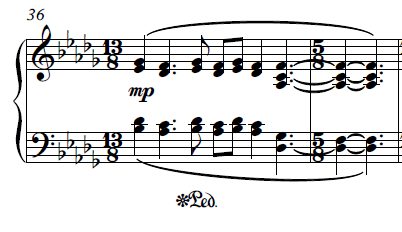
The Development starts as the same as the first theme, though it starts borrowing some of the same melodic contours as the second theme. This is ultimately setting the stage and screaming “THE CLIMAX IS COMING” over and over again (*cough*that’swhatshesaid*cough*). The repeated harmonic motif at 45-46 starts setting up the modulation at 49, and is pushed to the breaking point with the final change into polytonality Type VII-B2 and introducing the new expanded range and dynamic shift. The climax uses the same melodic material as the second theme, but with a few key expansions.
The first of these is the introduction of the thicker texture, moving through eight tone chords instead of four tone chords. The next key difference is the keys involved. The section starts in VII-B2, and the second phrase moves into VIII-B5 before mixing the keys and modes towards the end for the repeat and the end. The final notable thing is the range. The melodic material is in the highest range so far in the movement, and the thunderous bass is introduced, putting the roots of the chords against each other, strengthening the dynamic change to fortissimo. To avoid cluttering the bottom stave with the ranges involved, I opted to add a third staff with the bass separated to ensure the readability of the score. This has become increasingly common in my music in recent days.
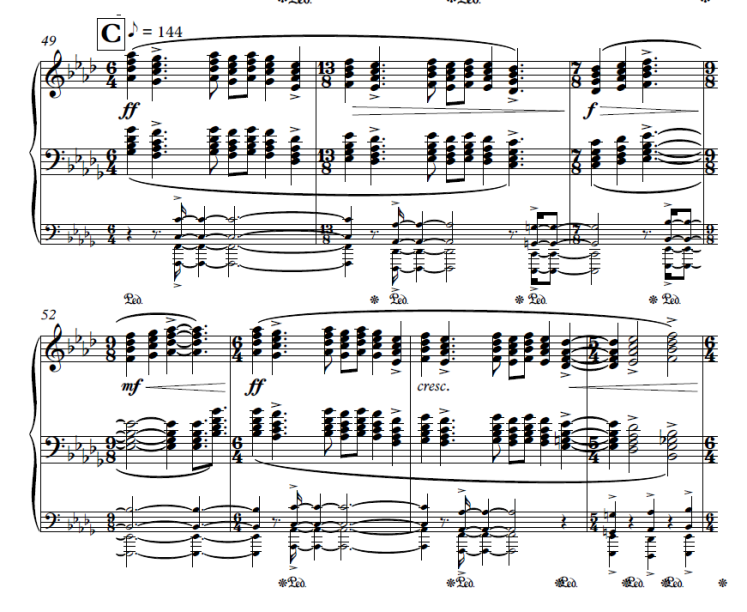
The use of VII-B2 and VIII-B5 is actually quite a calculated decision on my part. What I did was I took the lower notes in either hand in the second theme, and literally build chords off of them. Because the two voices are either a P5 or m6 apart, it becomes polytonal when written in diatonic parallelism. This flavor of polytonality (VII-B2) remains among my favorite combinations because it dances the line between polytonal and modal interchange consistently throughout the scale. It also harbors a very special chord that I’ll get to later. The climax ends with a cadential extension of the Db/Eb to Ab/Db at the end of the section, lengthening it and slowing down into the closing material of the Development.
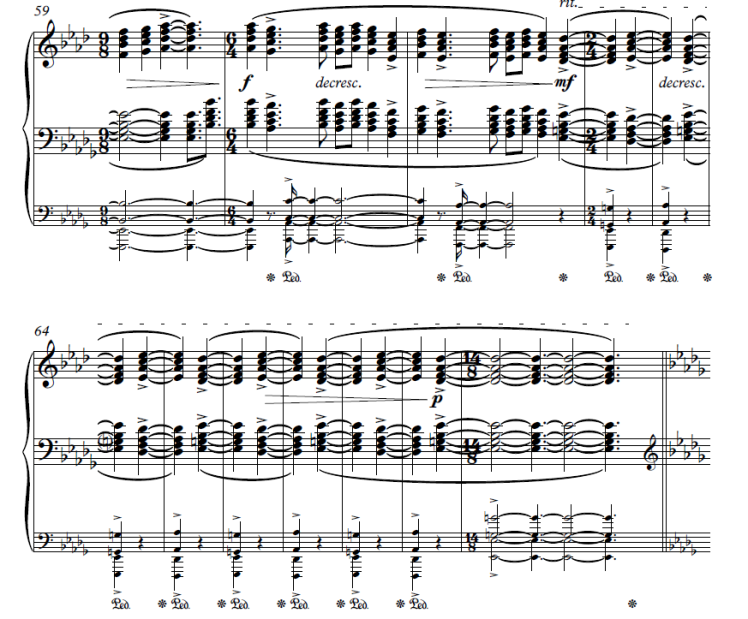
The closing material of the Development on to the end of the movement introduces a shift in octave that creates a feeling of delicacy, almost weakness, after the climax of the movement. The beginning of this uses a VII-A2 polychord and a Db major 7 chord alternation. I opted for the specific voicing of the Db major 7 chord to start pulling the music back to the first theme. The closing material then reintroduces the introduction of the climax to set up the return to the first theme. This is the only other Common Practice Period™ cadence in the work, which I can only really analyze as a half-diminished 13 for the sake of brevity. This pushes back into the first theme, which offers a dynamic retrograde as well as a ritardando into the final chords of the movement.
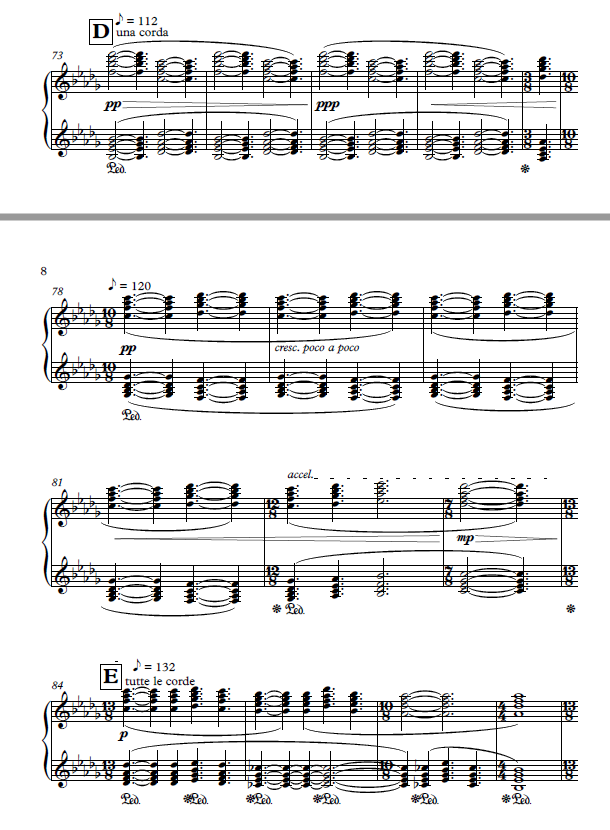
The ending has been altered somewhat dramatically from the first performance edition by lengthening the cadence, reintroducing the bass, moving everything up an octave, and thickening the chords a little bit. I did this to increase the ambiguity of the ending; it’s not as resolved as the original by far, and has more of an introspective spin on things. The best way I can describe it would be bittersweet rather than hopeful, though there is still a degree of that hope, just a bit more subtle and convoluted.
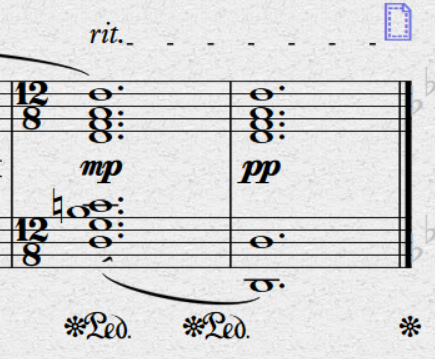

With the conventions and language that I use in this piece out of the way, I wanted to elaborate on the why of this whole thing. As I originally said, it began as an inspiration from a lecture on Debussy, though the work ended up being more Tavener than anything, but the story does not end there. Because I had been studying Rachmaninoff and Cage the semester before, I wanted to also incorporate some of that into the work. From Rachmaninoff came the thickness and general feel of the climax, as well as the three stave approach in the climax. The Cage work I studied, “In a Landscape,” was also a point of inspiration, though in a different manner than he did. His steady development, strict tempo, and dual modality brought a panoramic landscape to life, something I wanted to attempt but with dreams instead of a landscape. The landscape he sought was unchanging and steady, whereas dreams are fluid and almost chaotic. To this end, I sought constant irregular shifts in pulse and meter, as well as far thicker and more ambiguous textures, with patterns only really discernible on a closer inspection.
Hilariously, this was actually one of the first works I ever composed in a (relatively) stable major key. It’s also far more diatonic than other works of this period of composition for me. Before this point, a staple of my work included heavy chromaticism, free atonality (think 2nd period Schoenberg, but more chordal), and a heavy use of dissonance. While the dissonance stayed for this work, it’s far more tame than the dissonance used in any of my previous works. It marked a notable shift in my composition path that would ultimately lead me to using more of a pandiatonic and nonfunctional harmony in the rest of my work. Later, this becomes more mixed with some of my works like Prelude No. 1 in C Major, that marries some of the nonfunctional harmony with some of my earlier harmonic choices. Other works like “Hope” keep the nonfunctional harmony, but also reintroduce older conventions of my works, such as lament basses harmonized strictly in minor, and far more dense and dissonant chords, though it’s applied differently than before (building up to the chromaticism and dissonance rather than using it generously throughout).
I actually ended up using the second to last chord in the first theme in quite a few of my other pieces later. It ended up becoming a harmonic staple throughout my works in my undergraduate program, eventually becoming what I call the Anthony chord, or Anth. It functions as a IV chord and I use it in plagal cadences, though I’ve also been known to use it as statements of a tonic chord, like in my piece “A Flickering Light in the Dark.” The Anth chord is built by taking a major chord and adding a tritone above the tonic, and can be extended upwards to 13s and beyond. It occurs naturally as IV in major keys and I in lydian modes.

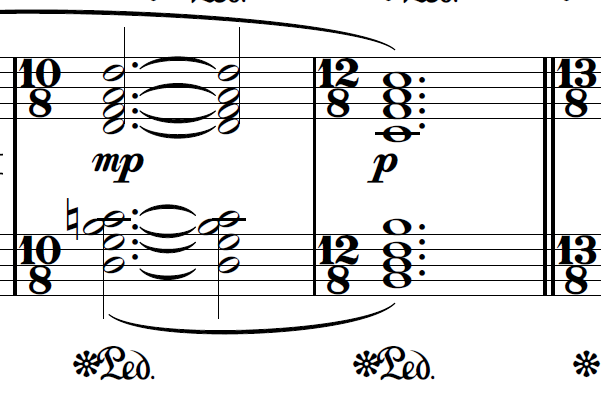
Now, this is hopefully not all that will be said on this work. What I want to do with this work is have a discussion about this piece between Djesso, Gimpybuttons, and myself to kind of elaborate on some things I may have missed in this write-up. Also below would be a link to the Soundcloud file so that you can hear this work, as well as see the excerpts. If anybody wants the full score of the work, email me at misterdrtheoryslapped@gmail.com with “Piano Sonata No. 1 Score,” or something along those lines, in the subject field. Unfortunately, this won’t be an option until I can set up some way for payment of the score, though it won’t cost much compared to other scores of similar length (probably like $5 or something).
I hope you have enjoyed this edition of Getting Inside Me.